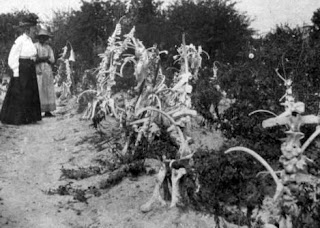Then one finds much later (stylized) appropriations of the visual form of the vertebrae sections, as ornamentation in Oxford, such as those seen on the engaged columns at the entrance to Queen's College (shown below).

Aunt Aggie's Bone Yard in Lake City, Florida was a popular tourist attraction for families in the early twentieth century. Aggie Jones (died 1918) was a former slave who created this natural history and botanical garden on property she and her family purchased after emancipation. Bones supported by wires were used to create archways and trellises ornamenting a white sand pathway. The garden was demolished after her death, and a school now stands on the site.
Dr. Paula Lee has edited a new interdisciplinary book addressing 19th-century slaughterhouses, titled Meat, Modernity, and the Rise of the Slaughterhouse (U New Hampshire Press, 2008). Lindgren Johnson's chapter, "To 'Admit All Cattle without Distinction': Reconstructing Slaughter in the Slaughterhouse Cases and the New Orleans Crescent City Slaughterhouse" will be especially of interest to readers here.
Oxford images above taken 07.2007 by K. Rylance. Aunt Aggie's Boneyard, c. 1915 from Images of Florida's Black History/Florida Memory Project of the State Archives of Florida. Click here for more.
No comments:
Post a Comment